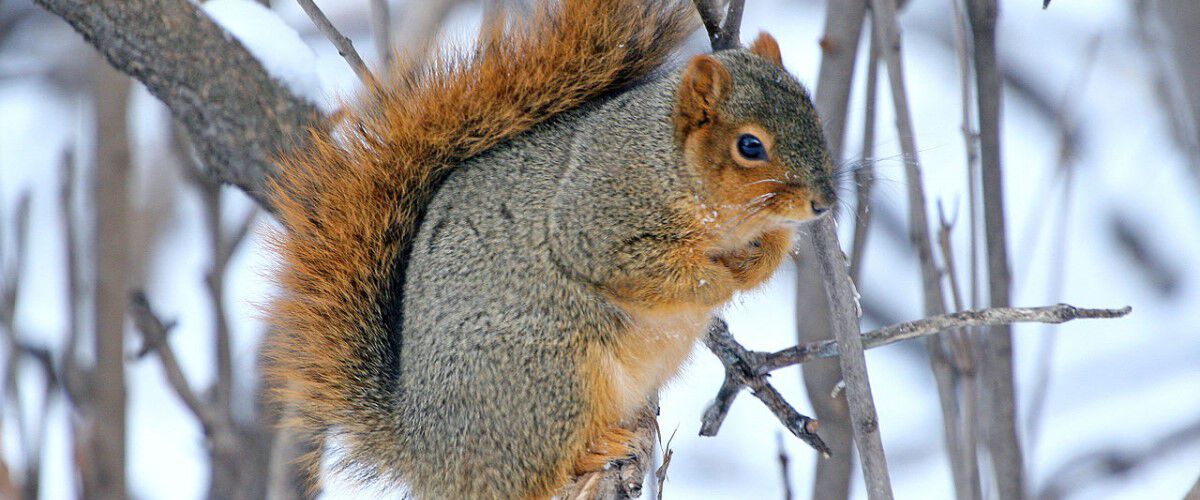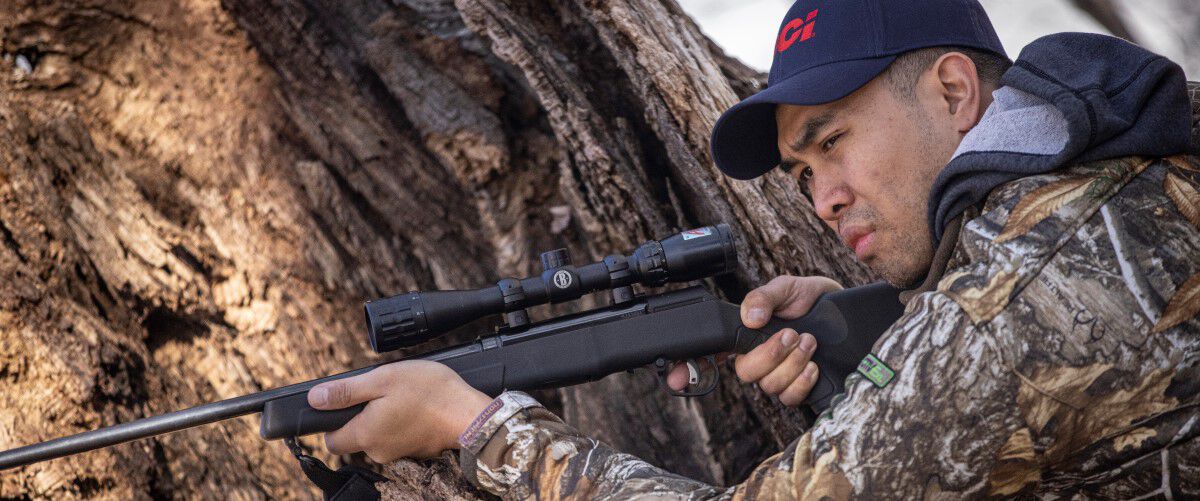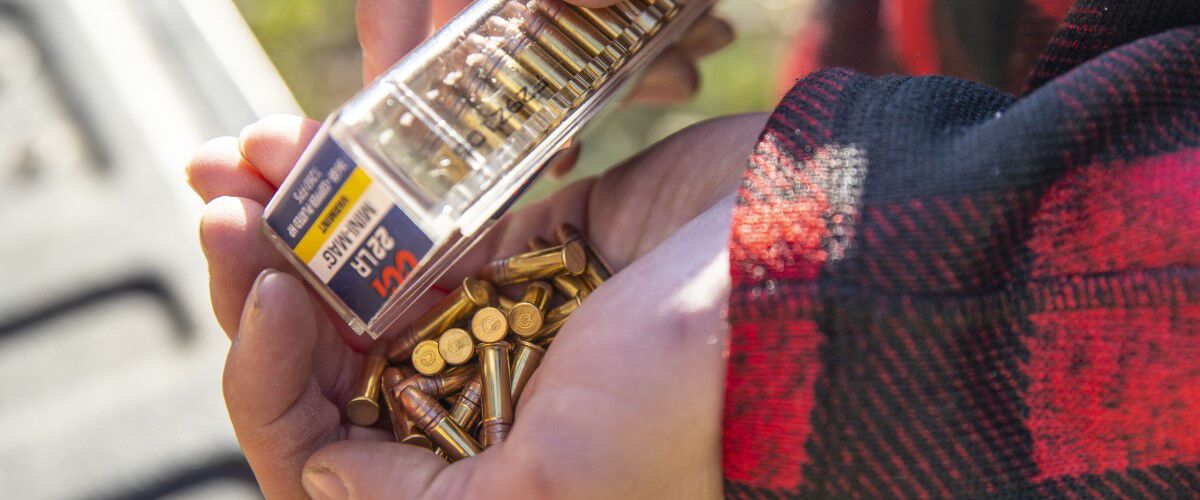Species Spotlight: Fox Squirrel
By Brad Fitzpatrick

No animal symbolizes the coming of fall and hunting season to me more than the Eastern fox squirrel. By September, the oppressive heat of summer gives way to the first cool air of autumn and fox squirrels take up residence in local hickory groves, gathering their store of food for the coming winter. In my family, as with so many others, it’s a long-held tradition to rise before the dawn and set up on the edge of those hickory groves when squirrel season arrives, waiting for the first flash of movement or dip of a leafy branch as a fox squirrel travels its highway along the treetops. From below, the eastern fox squirrel’s belly appears burnt orange color, the same as the autumn leaves. They were the first game animal I ever harvested, and I still look forward to pursuing them each year.
There are 10 subspecies of fox squirrels ranging from the eastern coast of Maryland and Virginia west to the Great Plains. Perhaps most familiar to hunters is the eastern fox squirrel I grew up hunting in the Midwest with its grey coat and rusty orange-red tail and belly, but in the longleaf pine forests of Florida and Georgia you’ll find the distinctive Sherman’s fox squirrel with its striking black head and white nose patch, and melanistic fox squirrels occur in some areas of the country. In eastern Maryland and Virginia, the large, light gray Delmarva fox squirrel is the most common subspecies.
Regardless of subspecies, fox squirrels are the largest tree squirrels on the continent. Weighing up to 3 pounds and measuring as much as 30 inches from nose to their tail, fox squirrels are considerably larger than the familiar gray and pine squirrels. While fox squirrel ranges often overlap with those of the Eastern grey squirrel, the two species generally utilize different habitats. Gray squirrels are largely forest dwellers, living deep in old-growth woods and thriving in areas with abundant ground cover. Fox squirrels, by contrast, prefer ecotones between open areas and mature forests, such as the borders of timber and agricultural fields, though fox and gray squirrels can sometimes be found in the same habitat.
Working For Winter
Most people know fox squirrels feed on mast crops like acorns, walnuts and hickory nuts, but they have a varied diet that also includes berries, green plants and insects. During the summer months, squirrels forage throughout the day to add fat stores for the winter. They also cache food items, particularly nuts, by burying them in the ground (the lost or forgotten ones help expand forests) or in a tree hollow. During winter, squirrels return to their cache sites to collect food.
Because squirrels spend so much of their time collecting and storing food, it’s beneficial for hunters to identify food sources and hunt in these areas. A single hickory or oak tree might provide food for dozens of fox squirrels, making them the perfect location to set up and wait for squirrels to appear. On the property I hunt, a single stand of hickory trees is the prime destination for hunting fox squirrels simply because this ready food source attracts and holds so many squirrels in a single location. Finding such a food source is the simplest and most efficient way to hunt fox squirrels.
Other Methods
Of course, there are other ways to fill your game bag. One is to float along a creek or river in a canoe, or simply wade these same waters while carrying a rimfire rifle or pistol. Fox squirrels are commonly found along waterways, and hunting from a canoe lets you to cover more ground than you would by wading. The advantage of wading, though, is that you will be able to get a more stable shot, especially if you carry a monopod shooting stick. The stick serves as a platform for your rifle or pistol, but it’s also handy to check the depth of water ahead of you. Being in a canoe makes getting a steady shot difficult: your options are to steady the boat (usually by placing one foot on the bottom of the creek) or to land the canoe and fire when it comes to rest.

Fox squirrels are vocal creatures, too. Not only do they whistle and bark in alarm—something that irritates all deer hunters—but they also respond to these calls. It’s possible to draw fox squirrels into gun range using a call that imitates a young squirrel in distress. I had doubts about the effectiveness of these calls, but after witnessing a fox squirrel come barreling directly into my setup the first time I used one of these distress whistles all skepticism was erased. To enhance the effectiveness of the call you can shake leaves on the ground to imitate a struggle, but be ready because the response might be immediate and dramatic.
Hunting with dogs is another favorite method. Classic American breeds like the fiest and mountain and blackmouth cur, all of which were originally bred for treeing game, make excellent squirrel dogs. Since fox squirrels are abundant over much of their range it’s easy to train these dogs, too. After enough sight chases, they’ll learn to use their nose as well, and once your dog has figured out the game you can expect lots of action each time you head to the woods.
Squirrel On The Plate

Regardless of how you plan to cook squirrel you need to damage as little meat as possible. I grew up hunting squirrels with shotguns, which accounted for a lot of meat loss. These days, I hunt them almost exclusively with a rimfire. If I can place the bullet in the squirrel’s head, there’s no chance I’ll lose it and no meat is lost. Most any 22 LR load will do, but my favorite is CCI’s Mini-Mag HP because it offers excellent accuracy combined with dramatic terminal performance.
Hunting big game is obviously exciting, but chasing fox squirrels is a nice change of pace. These animals thrive in a variety of habitats, but they require plenty of patience and an accurate rifle. Before the season ends, take some time to head into the woods, scope out a likely spot, and spend a few relaxed hours watching for bushytails. You’ll have an opportunity to test your hunting skills and bring home meat for the freezer.